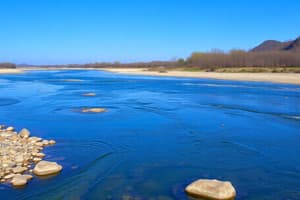Podcast
Questions and Answers
What causes the formation of small islands separated by river channels called distributaries?
What causes the formation of small islands separated by river channels called distributaries?
- Erosion of the riverbed by hydraulic action
- The collapse of hard resistant rock over softer rock
- The retreat of waterfalls upstream
- Deposition of fine material as the river's velocity slows (correct)
What leads to the formation of a plunge pool at the base of a waterfall?
What leads to the formation of a plunge pool at the base of a waterfall?
- The great power of the water at the base of the waterfall (correct)
- The formation of gorges upstream
- Erosion of the hard resistant rock by hydraulic action
- The collapse of the overhanging hard rock
What is the main cause of the formation of gorges over time?
What is the main cause of the formation of gorges over time?
- Erosion of the riverbed by hydraulic action
- Repetition of the process of waterfall retreat (correct)
- Deposition of fine material as the river's velocity slows
- The collapse of hard resistant rock over softer rock
What leads to the undercutting of harder rock and the subsequent formation of waterfalls?
What leads to the undercutting of harder rock and the subsequent formation of waterfalls?
What leads to the formation of a steep river cliff in a meander?
What leads to the formation of a steep river cliff in a meander?
What is the result of lateral erosion by meanders?
What is the result of lateral erosion by meanders?
What is the characteristic of a flood plain?
What is the characteristic of a flood plain?
What forms a delta?
What forms a delta?
Water flowing around a meander moves fastest on the outside of the bend leading to erosion and the formation of a steep river ______
Water flowing around a meander moves fastest on the outside of the bend leading to erosion and the formation of a steep river ______
A flood plain is the wide, flat area of land on either side of the river in its middle and lower ______
A flood plain is the wide, flat area of land on either side of the river in its middle and lower ______
Levees are natural embankments of silt along the banks of a river, which are often several metres higher than the flood ______
Levees are natural embankments of silt along the banks of a river, which are often several metres higher than the flood ______
A delta is a flat area of sand and silt built into the ______
A delta is a flat area of sand and silt built into the ______
Waterfalls form when a band of hard resistant rock (cap rock) lies over softer, less resistant ______.
Waterfalls form when a band of hard resistant rock (cap rock) lies over softer, less resistant ______.
The great power of the water at the base of the waterfall causes a plunge pool to ______.
The great power of the water at the base of the waterfall causes a plunge pool to ______.
Over time the process above is frequently repeated and eventually a steep-sided ______ forms as the waterfall retreats upstream.
Over time the process above is frequently repeated and eventually a steep-sided ______ forms as the waterfall retreats upstream.
When a river enters the sea carrying large volumes of fine material, the velocity slows and causes the load to be deposited in ______.
When a river enters the sea carrying large volumes of fine material, the velocity slows and causes the load to be deposited in ______.
Flashcards are hidden until you start studying




